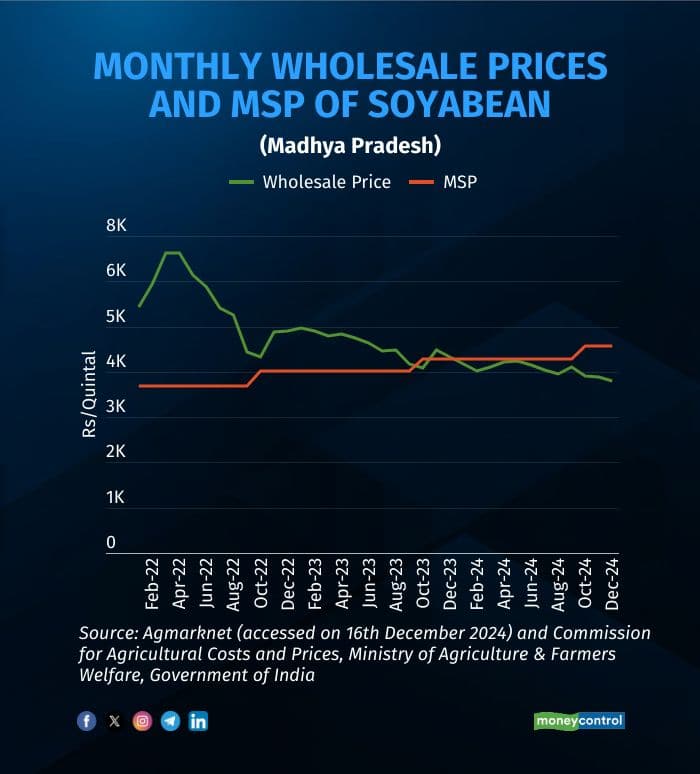



It is heartening to note that the financial world is now optimistic about rural economy, but quite concerned about slowing of urban consumption. For several years, rural recovery was the dominant theme for stock market participants. The question now is whether the rural recovery can be taken for granted and how much it can contribute to private consumption?
Even though the average income of a farm household from crop cultivation is only about 37 percent (as per Situation Assessment Survey of Agricultural Households, 2019), it remains a major source of earning for medium and large farmers (about 70 percent). So, it would be wrong to infer that cultivation of various crops will remain unaffected from the impact of poor price realisation from crops.
To contain food inflation, the Union Government has been imposing several restrictions on exports - stock limits on several agricultural crops, suspension of futures trading and restrictions on export. The market players partially attribute the current lower than minimum support price (MSP) of several commodities to these measures.
Vegetables and fruits are however exceptions, and they are major contributors to current food inflation.
Even holding on to stock doesn’t helpDue to various initiatives of the Government, the farmers do not sell their entire produce immediately after harvest. A recent study of gram and mustard farmers in MP and Rajasthan found that the farmers in Madhya Pradesh and Rajasthan stored their mustard and gram harvest for a period of 102 to 114 days. If they have no hope of realising the MSP even after storing their harvest for several months, in expectation of higher prices, they would be distressed and they are bound to cut down their consumption (FMCG, white goods etc.).
Three key crops where market price is below MSPThis year, due to good monsoon, the farmers increased the area of pulses and oilseeds but the prices of moong and soybean are below MSP.
The market price of green moong (whole) in some regions of India has fallen below MSP of Rs 8558 per quintal (chart below) as the Government agencies are not procuring it.

Similarly, the soybean prices are ruling around Rs 4,000 per quintal while the MSP is Rs 4,892 per quintal.

The procurement of soybean by Nafed is too slow and signs of distress are quite visible. In Madhya Pradesh and Maharashtra, soybean is the third major cultivated crop and low-price realisation from soybean will have surely reduced their income.
One reason for low prices of soybean is that the processing industry is not willing to pay MSP as the oil meal prices are depressed. They point out that the price of maize DDGS (Distiller's dried grains with solubles), produced when it is used for manufacturing ethanol, is only around Rs 13 per kg while the soymeal is Rs 27 per kg. The DDGS obtained from rice is Rs 18 per kg. Last year, around this time, the soymeal prices were around Rs 40 per kg.
Groundnut prices are also below MSP despite damage to the crop in Gujarat due to irregular rainfall (see chart).

Moong, tur, soybean and groundnut are grown by small farmers in kharif in (mostly) rainfed areas. Due to good monsoon, the crop has been good. It will be a real misfortune if they do not realise a fair price due to absence of procurement by the Government agencies. They may not be agitating like the farmer of Punjab, but they would hardly be perceiving current times as Amrit Kaal.
Even basmati paddy is below last year’s priceIt is not only soybean and moong farmers who are unable to realise a fair price. Even the basmati paddy in Punjab, Haryana, Madhya Pradesh and Uttar Pradesh is selling around Rs 3,000 per quintal against Rs 4,000 per quintal last year. There is no MSP for basmati paddy and the farmers are entirely dependent on private trade, especially exports.
In the next two weeks, tur crop will start arriving in markets. Its price trend will be closely watched.
In the meantime, the Government agencies in MP, Chhatisarh and Odisha are procuring paddy at Rs 3,400 per quintal while the MSP is Rs 2,320 per quintal. So, going forward it has to be confirmed whether the rural recovery is stronger in states where the price realisation is better.
ConclusionWhile food inflation remains a top priority for the Government, it should also take all possible steps to ensure that the prices do not fall to un-remunerative levels. It is bad for food security and even worse for businesses which depend on rural consumption.
Discover the latest Business News, Sensex, and Nifty updates. Obtain Personal Finance insights, tax queries, and expert opinions on Moneycontrol or download the Moneycontrol App to stay updated!
Find the best of Al News in one place, specially curated for you every weekend.
Stay on top of the latest tech trends and biggest startup news.